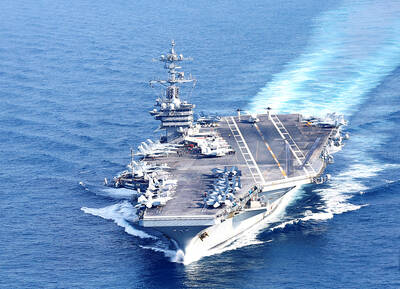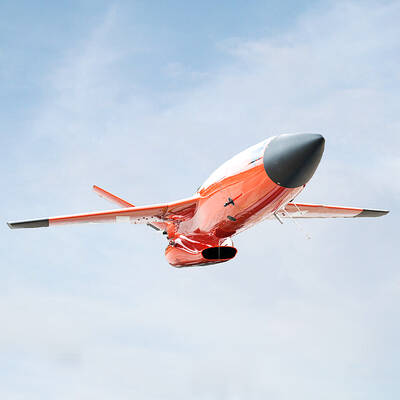China’s first landing of a plane on one of its new island runways in the South China Sea shows Beijing’s facilities in the disputed region are being completed on schedule and military flights will inevitably follow, foreign officials and analysts said.
China’s increasing military presence in the disputed sea could effectively lead to a Beijing-controlled air defense zone, they said, ratcheting up tensions with other claimants and with the US.
Chinese Ministry of Foreign Affairs officials on Saturday said that a test flight by a civilian plane landed on an artificial island built in the Spratly Islands (Nansha Islands, 南沙群島), the first time Beijing has used a runway in the area.
Vietnam launched a formal diplomatic protest while Philippines Ministry of Foreign Affairs spokesman Charles Jose said Manila was planning to do the same.
Both nations have claims to the area that overlap with China and Taiwan.
“That’s the fear, that China will be able take control of the South China Sea and it will affect the freedom of navigation and freedom of overflight,” Jose said.
In Washington, US Department of State spokesman John Kirby on Monday said China’s landing of the plane “raises tensions and threatens regional stability.”
US Senator John McCain, the chairman of the Senate Armed Services Committee, criticized US President Barack Obama’s administration for delaying further “freedom of navigation” patrols within 12 nautical miles (22.2km) of the islands built by China.
McCain said that the lack of US action was allowing China to continue to “pursue its territorial ambitions” in the region.
He said the Obama administration was “either unable to manage the complexities of interagency national security decisionmaking or simply too risk averse to do what is necessary to safeguard the rules-based order in the Asia-Pacific.”
China has been building runways on the artificial islands for more than a year, and the plane’s landing was not a surprise.
The runway on Fiery Cross Reef (Yongshu Reef, 永暑礁) is 3km long and is one of three China was constructing on artificial islands built up from seven reefs and atolls in the Spratlys.
The runways would be long enough to handle long-range bombers and transport craft as well as China’s best jet fighters, giving them a presence deep into the maritime heart of Southeast Asia.
Chinese officials have repeatedly said that the new islands would be mostly for civilian use.
However, military landings on the islands were now “inevitable,” said Leszek Buszynski, a visiting fellow at the Australian National University’s Strategic and Defence Studies Centre in Canberra.
An air defense zone, while unlikely soon, was feasible and possible in future once China builds up its air strength, he said.
“The next step will be, once they’ve tested it with several flights, they will bring down some of their fighter air power — SU-27s and SU-33’s — and they will station them there permanently. That’s what they’re likely to do,” he said.
Ian Storey, a South China Sea expert at Singapore’s ISEAS Yusof Ishak Institute, said he expected tensions to worsen as China used its new facilities to project power deeper into the South China Sea.

CROSS-STRAIT COLLABORATION: The new KMT chairwoman expressed interest in meeting the Chinese president from the start, but she’ll have to pay to get in Beijing allegedly agreed to let Chinese Nationalist Party (KMT) Chairwoman Cheng Li-wun (鄭麗文) meet with Chinese President Xi Jinping (習近平) around the Lunar New Year holiday next year on three conditions, including that the KMT block Taiwan’s arms purchases, a source said yesterday. Cheng has expressed interest in meeting Xi since she won the KMT’s chairmanship election in October. A source, speaking on condition of anonymity, said a consensus on a meeting was allegedly reached after two KMT vice chairmen visited China’s Taiwan Affairs Office Director Song Tao (宋濤) in China last month. Beijing allegedly gave the KMT three conditions it had to

STAYING ALERT: China this week deployed its largest maritime show of force to date in the region, prompting concern in Taipei and Tokyo, which Beijing has brushed off Deterring conflict over Taiwan is a priority, the White House said in its National Security Strategy published yesterday, which also called on Japan and South Korea to increase their defense spending to help protect the first island chain. Taiwan is strategically positioned between Northeast and Southeast Asia, and provides direct access to the second island chain, with one-third of global shipping passing through the South China Sea, the report said. Given the implications for the US economy, along with Taiwan’s dominance in semiconductors, “deterring a conflict over Taiwan, ideally by preserving military overmatch, is a priority,” it said. However, the strategy also reiterated

‘BALANCE OF POWER’: Hegseth said that the US did not want to ‘strangle’ China, but to ensure that none of Washington’s allies would be vulnerable to military aggression Washington has no intention of changing the “status quo” in the Taiwan Strait, US Secretary of Defense Pete Hegseth said on Saturday, adding that one of the US military’s main priorities is to deter China “through strength, not through confrontation.” Speaking at the annual Reagan National Defense Forum in Simi Valley, California, Hegseth outlined the US Department of Defense’s priorities under US President Donald Trump. “First, defending the US homeland and our hemisphere. Second, deterring China through strength, not confrontation. Third, increased burden sharing for us, allies and partners. And fourth, supercharging the US defense industrial base,” he said. US-China relations under

The Chien Feng IV (勁蜂, Mighty Hornet) loitering munition is on track to enter flight tests next month in connection with potential adoption by Taiwanese and US armed forces, a government source said yesterday. The kamikaze drone, which boasts a range of 1,000km, debuted at the Taipei Aerospace and Defense Technology Exhibition in September, the official said on condition of anonymity. The Chungshan Institute of Science and Technology and US-based Kratos Defense jointly developed the platform by leveraging the engine and airframe of the latter’s MQM-178 Firejet target drone, they said. The uncrewed aerial vehicle is designed to utilize an artificial intelligence computer